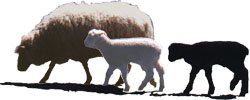
"Natural color, naturally raised, naturally good sheep."
Why Wool for Quilt Batts?

- Wool is fire retardant.
-
Wool is easy to use for hand quilting
and machine quilting. - Wool is natural, warm and lightweight.
-
Quilt batting with Wool from local sheep
is GREEN and good for the planet.
Why Wool Is Best
Several factors contribute to the comfort which wool/natural fibers provide and the measurable, beneficial impact it has on the quantity and quality of sleep. Wool/natural fiber is a natural insulator that helps regulate the body temperature to help provide a better night's sleep. Wool/natural fiber will not overheat or under heat you.
Wool fibers are springy and naturally resilient. The structure of wool fiber batting contains an abundance of air. This fiber/air combination acts to cushion the body and prevent the formation of annoying and often painful pressure points.
Wool fibers handle moisture better than any other fiber without losing its insulating properties. Wool fibers have the ability to absorb large amounts of moisture vapor without feeling wet and clammy. The average person gives off a pint of water vapor as perspiration during an eight hour sleep period under a comforter. The ability of the wool fiber to handle this moisture is very important. Wool wicks away moisture from the body. The responsive fiber responds according to your temperature changes.
Wool fibers are long lasting. Wool can bend itself 20,000 times without breaking. It lasts for years without losing its resilience.
Wool fibers are Dust Mite resistant. Wool dries very quickly and dust mites don't like dry places.
Wool and most natural fibers are a natural fire retardant.
Wool fibers are naturally mildew and mold resistant.
Wool fibers provide a "natural climate zone" effect, which is especially advantageous in a pillow. Large quantities of body moisture are produced in the head area. The moisture and the pressure of the head are concentrated in a relatively small area, with head weight and movement tending to force the moisture down into the pillow filling.
Wool fibers are the most perfect insulator. They insulate without over heating. Historically used in both the heat of the desert and the coldest arctic climates. Wool is worn in many areas of the world to keep warm, yet the Bedouins of the Sahara wear wool because it keeps them cool. The tiny air pockets inside the wool fibers provide natural insulation.
A study conducted by the Ergonomics Unit at the Polytechnic Institute of Wales confirmed that a wool filled comforter is more comfortable than the equivalent in weight and construction of synthetic comforters. The physiological data showed that: The heat rate under the wool filled comforter was significantly lower 100% of the time. The humidity next to the skin under the wool comforter was significantly lower 71% of the time. The temperature rise of the skin above 91 degrees, which is considered to be the optimum level for sleep comfort, was significantly higher under synthetic filled comforters 80% of the time.
Results from a study at the Hohenstein Research Institute in Germany showed similar results. The findings illustrate that it is not just the construction of the comforter that makes it the best fiber to sleep on or under, but that there is an inherent benefit offered by the wool fiber itself.
Wool Versus Synthetic Fibers: Because micro-fibers and synthetic fibers contain smooth fibers, they do not offer proper support. They do not resist each other when they come into contact with each other. As a result, synthetic fibers bottom out when body weight is directly applied. They cannot support the body weight as well, nor distribute weight away from pressure points of the body. Synthetic materials also do not absorb moisture. Fiber breakage is also a problem over time. And of course, with synthetic fibers, you don't get the "natural climate zone" effect or the resilience like you do with the wool. Wool fibers are supportive yet soft.
Wool Versus Down: Goose down, which is usually a mix of the soft underbelly plumes and feathers, provides more support than smooth synthetic fibers, but still tends to bottom out under body weight. Therefore, it does not support or distribute the body weight away from the pressure points of the body. Down can absorb moisture but it does not dry quickly which can make it wet to the touch and very uncomfortable to be in contact with it.
Due to its physical structure and its natural chemical make up, wool fill handles body moisture under warm and cool sleeping conditions in a manner superior to any competitive cotton, down or synthetic fiber. Down and cotton have the additional disadvantage of losing their loft as they become damp.
Wool forms the protective covering of sheep, screening them from heat and cold, and allowing them to maintain even body temperatures. The same properties are a benefit to all products made from wool.
The preceding "Why Wool Is Best" section is from Zeilinger Wool Processors in Wisconson USA (where our wool batts are processed) and reprinted with permission.